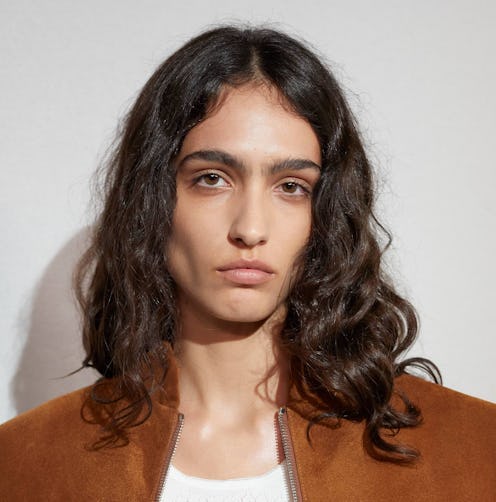(Hair)
Is The Death Of Microblading Upon Us?
Why everyone is getting their tattooed brows removed.

Microblading — the brow treatment popularized by social media and now widely available at brow studios — promises a quick and easy way to wake up with seemingly full, fluffy brows with minimal maintenance. For those unfamiliar, it’s a tattoo service where tiny incisions are made in the skin and then filled in with pigment to resemble brow hairs. The results should be fresh and natural-looking, but unfortunately, a lot can go wrong, especially since anyone can get licensed online to perform it. Michele Holmes, a Bay Area-based eyebrow shaping expert and founder of Rye Beauty, says that while there are many amazing brow artists that do microblading well, the untrained ones can — and are — causing long-term issues, including skin thickening, color altering, and poor shaping technique. As a result, many brow artists are seeing a clap-back from clients in the form of microblading removal.
And while brow experts are busy doing course correction for bad ‘blading, dermatologists are also not keen on the trend, as tattoos temporarily damage the skin biome. Dr. Hadley King, M.D., a board-certified dermatologist in New York City, says that just like a regular tattoo, the side effects can be troublesome beyond aesthetics. “Any time the skin barrier is penetrated, there is risk of bacterial viral infections, particularly if the procedure is performed by an untrained person under unhygienic conditions,” she says, adding that the FDA does not regulate the color additive substances used in microblade pigments. “Just make sure to go to a licensed aesthetician and do your research [beforehand].”
Below, what to know before you go under the blade. Plus, whether brow experts think the end of microblading is near.
The Under-The-Radar Side Effects Of Microblading
Holmes warns that the potential pitfalls are many, citing shifting brow shades as a common side effect. “When the ink starts to fade, color can change, which means that a more dominate shade could absorb faster in the body than others that are blended into the ink,” she says. “If you’ve ever seen someone with bluish or burgundy brows, they either faded that way or the artist didn’t adjust the color to address the client’s natural skin tone.”
The brow expert explains that your skin’s undertones need to be taken into account when brow color is customized or it can have a negative effect on the healed hue. Yetty Bames, brow specialist at Sharon Dorram Color at Sally Hershberger in New York City, adds that the skin on the brow area can actually reject the ink, and ultimately, won’t fade as intended (in her practice she has seen brows slide into green tones). But arguably worse than changing brow color is potentially causing real injury to the skin. Both Bames and Holmes have seen permanent damage like raised keloids or tiny little scars from hard hand pressure. “Pressing too hard during the service causes lymph fluid to surface at the microblading site and can ultimately cause scars,” Holmes says.
Removing Microblading From Your Brows
For those who regret their microbladed brows, removal is possible, but it’s tricky. Holmes says the best way to reverse microblading is with a laser, which can ironically zap brow hairs. “I’ve seen one case where the top arch of a brow was actually erased by laser removal,” she says, adding that since laser removal can permanently remove hair, it’s better and more effective for those with tattoos on bare skin areas. She prefers saline reversal, which requires multiple sessions but is a gentler route and tends to keep precious brow hairs intact. Kelley Baker, a Los Angeles-based celebrity brow expert (beloved by beauty editors and Kardashians alike), says that people are getting really desperate (and creative) for ways to de-ink. “I’ve seen people attempt to tattoo white ink over their dark microbladed brows to try to soften their look after a bad application of pigment,” she says. Baker notes that this course of action rarely has a natural looking outcome.
The Downfall Of Microblading & Brow Aesthetics
Experts say they’re seeing a shift from “perfectly precise” brows that appear to be stenciled in to more natural, lower-maintenance arches. Holmes says she leans toward “symmetrical brows that have a little natural nuance to the design” and uses custom tinting, lamination, and tweezing to achieve a bespoke look for each client. “I’ve named this the ‘Hybrid Brow’ at my salon because I mix techniques, and see this as being the trend for 2024,” she says. “Think ‘fluffy brow tips’ and tidy eyelids.” Baker agrees and reminds us that while tattooing can offer the appearance of fullness, it cannot add the fluffy factor you see all over social media.
The Bottom Line
Bames says that while there was an explosion of the microblading trend, people are starting to pushback as a lot of her clients have been very unhappy with their results. Holmes adds that while microblading can initially look great and really natural, after the healing process, some of the crucial lines can fade away or even expand. “Listen, I still refer people to my approved microblading artist network, but I also recommend services like nano or powder brows as a more gentle alternative.”
And finally, Baker acknowledges that microblading is a great option for those who truly need the service (like those with alopecia, chemotherapy patients, or those with scars they want to camouflage), but should not treat the service as a shortcut solution to filling in your brows with products. “And if this is a treatment you want to try, just make sure to look at reviews, research photos of your artist’s work, and ask about long-term results before committing to a treatment that has the potential of a bad outcome that can last forever.”